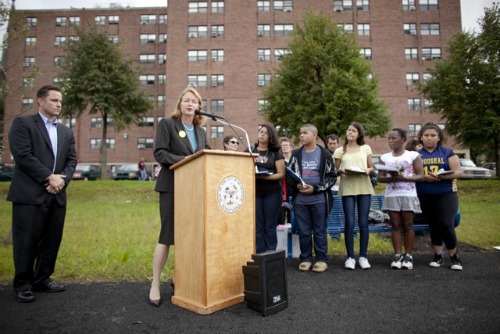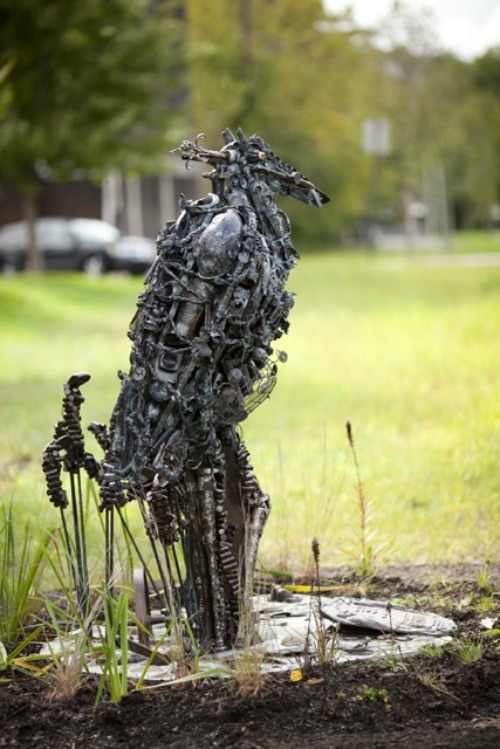Partnerships make Greenway a reality
A narrow trail of railroad tracks that once divided South Bethlehem is now uniting the community, thanks to an ambitious project that has turned the abandoned tracks into a scenic linear park and paved path.
Lehigh University has worked closely with the City of Bethlehem and other community partners to help make the South Bethlehem Greenway a reality, and on Wednesday, the latest evidence of this collaboration was officially recognized during a public dedication.
Lehigh President Alice P. Gast, together with Mayor John Callahan, sculptor Virginia Abbott, students from Broughal Middle School and representatives from ArtsQuest and Community Action Development Corp., dedicated the first sculpture and native plantings, which were installed at the intersection of Taylor and Webster Streets, just north of Lehigh’s campus.
“This is a tremendous community effort,” said Gast, who was on hand for the groundbreaking of the Greenway just one year ago. “It’s an opportunity to take stock of, and celebrate, the different partnerships that have formed over the last year.”
Gast, ensuring that those partnerships would continue to grow, announced that Lehigh would pledge $225,000 to help improve the trail as well as fund a security camera and a grade crossing at New Street. The funds will allow work to continue between Adams and Webster Streets and open the Greenway to other community groups, including the Boys & Girls Club of Bethlehem and Holy Infancy School.
A collaborative effort
Lehigh’s South Side Initiative, utilizing a grant from South Side Vision 2014, developed the space where 10 species of native plants were planted. Jason Slipp, senior instructional technologist in LTS and a member of the South Side Initiative’s (SSI) Community Gardens Working Group, spearheaded the planting.
“It’s been extremely collaborative between a city, a university, a non-profit and the citizens,” said Slipp, who received help and expertise from various faculty, staff and students as well as a local native plant expert.
Slipp, speaking at the dedication, said that this was just the first of four phases envisioned for the native plant space. He would like to see raised beds and a children’s native nursery develop in the next phases of the project. The Greenway development is a strong fit for the SSI, which focuses not only on community issues, but also broader issues of environmental sustainability and the challenges facing local and global food systems.
The dedication also unveiled “Blue Herons,” the first sculpture installed at the Greenway. Abbott, with assistance from eight budding sculptors from Broughal Middle School, created the piece from found objects. The blue herons, native to the area, symbolize healthy communities as the well-being of the heron is an indicator of the overall environmental health of a community.
Lehigh has been involved in many aspects of the Greenway since its inception. Throughout its development, students in the Integrated Learning Experience (ILE) program have been developing ideas, including architectural designs and physical improvements, for a section of path running between Third and Fourth streets from New Street to Taylor Street.
“Lehigh is at its best when we bring the things we learn in the classroom into the community,” said Gast, adding that the university is now working with the city to help make the ILE plans a reality.
Callahan, recognizing Lehigh’s contributions said, the “South Bethlehem Greenway is the city’s newest recreation space and it has already proven to be a popular destination. It’s so great to see how much the community here in South Bethlehem has embraced the Greenway.”
Posted on:



